Expert-Approved Ways to Easily Store Christmas Decorations Without Stress or Damage
These expert tips for packing away your festive items will make decorating next year easier and save space


By the end of our festivities, most people are exhausted and very ready for Christmas decorations to be stored away. As such, ornaments, lights, wreaths, and other festive trinkets can often end up in crowded bins, tangled or bashing together.
Not only can this damage delicate items, but it also makes decorating next year more difficult, too.
Our ultimate guide on storing Christmas decorations easily and without damage delves into stress-free storage ideas for every type of festive decor, whether you live in a cozy apartment with limited space or a spacious house with multiple options.
The Ultimate Guide to Storing Christmas Decorations
Before you start taking down all of your Christmas decor ideas, it helps to have some essential kit ready to make the process easier and prevent a stop-and-start approach that can lead to disorganization:
- A small parts organizer: Available at Walmart, this can help to corral small essentials such as reusable clips, batteries, spare lightbulbs, twist ties, and so on, ready for easy use again next year.
- A small screwdriver set: Also from Walmart, a small screwdriver can come in handy to help remove batteries from items before storage to prevent battery leaks in storage.
- Gardening gloves: From Amazon, a set of gloves can help when taking down real-foliage decor, such as holly, without nicking your skin.
- Drywall repair kit: Available from Amazon, it can help you patch up any accidental damage caused by your decorations.
- A label maker: Such as the DYMO label maker from Walmart, is ideal for labeling boxes by room for easy decorating next year.
- Heavy-duty trash bags: Available from Amazon. This is useful to keep on hand for any decorations that are ready to be trashed, recycled or, if in good enough condition, donated. There's no point storing items you have grown weary of and are unlikely to use again.
Picking Storage Solutions
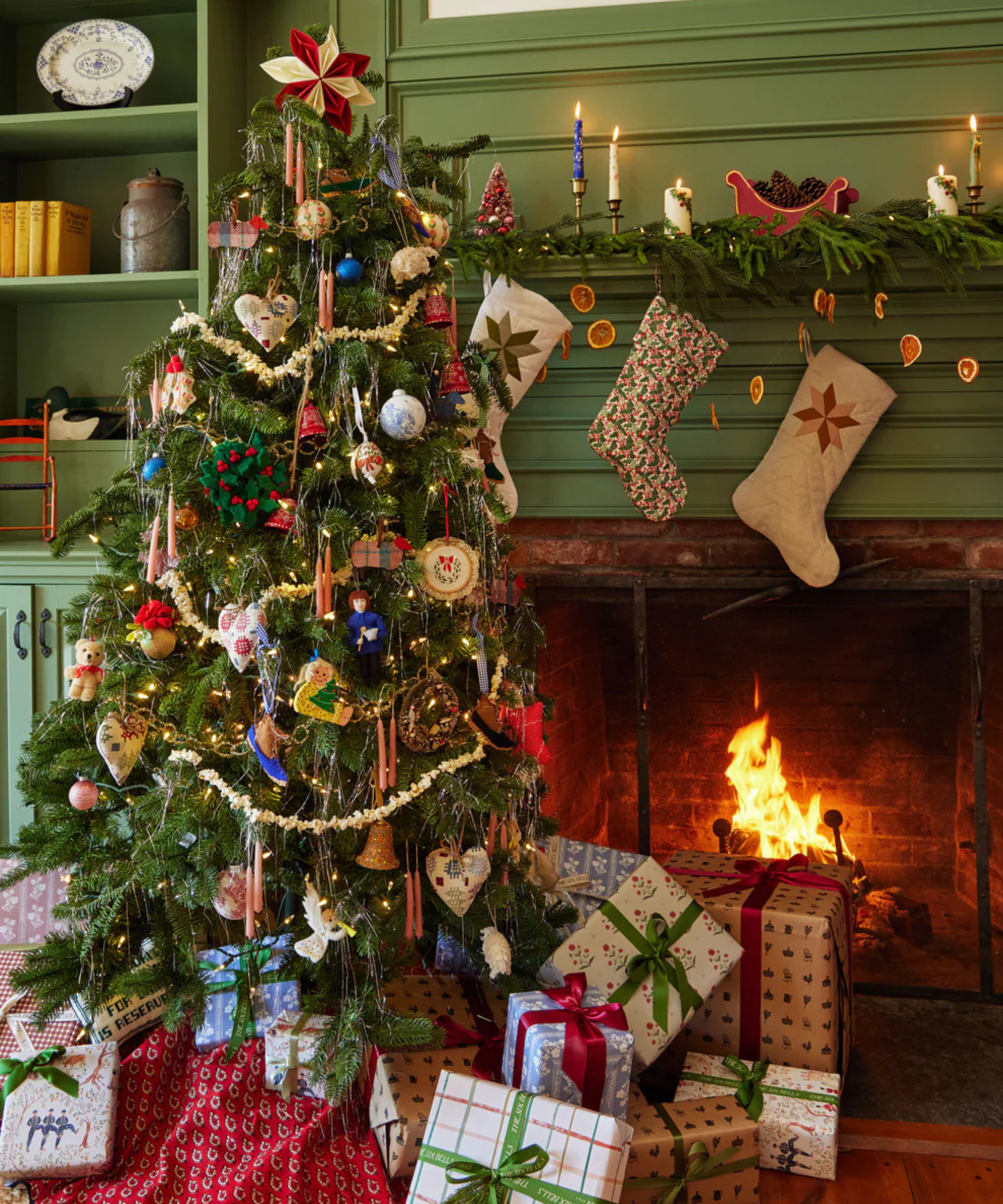
The right storage makes decorating next year a breeze.
Laura Price, professional home organizer and owner of The Home Organization, says, 'Taking down the decorations is not always the most enjoyable task, but it’s a chance to restore and refresh your home so it’s ready for the new year.'
Having some storage products professional organizers can't live without is a key part of this, helping to protect your decor from damage and keep your
'Don’t just pull your decorations down in a frenzy, be methodical,' Laura urges. 'Group items together, such as lights, baubles, and tinsel, and find suitable protective packaging for them. Also, make sure you label what’s what, so putting up the decorations next year isn’t an unnecessary hardship.'
Design expertise in your inbox – from inspiring decorating ideas and beautiful celebrity homes to practical gardening advice and shopping round-ups.
The Niimbot Label Maker, from Walmart, is ideal for this, connecting to your phone for easy labeling.
With that in mind, it is best to stock up on the following:
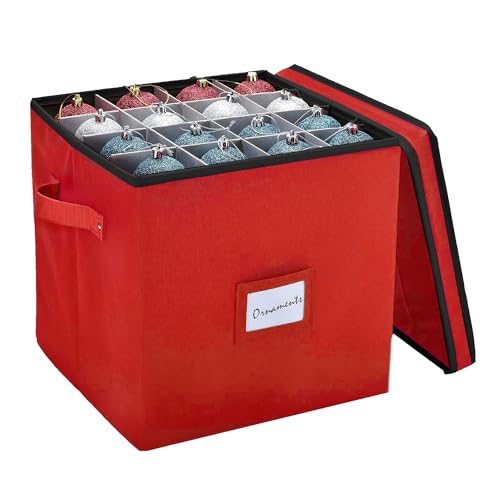
Amélie Saint-Jacques, professional home organizer, certified Kon-Mari consultant, and owner of Amélie Organizes, says, 'For storing decorations, I love a bin with dividers like this one from Amazon. This helps keep decorations safe from dust and breakage, while keeping them together, easily visible, and accessible. Storing fragile things in too many layers of tissue paper will work against you because you risk forgetting some of them or accidentally throwing them out because you think it's just paper.'
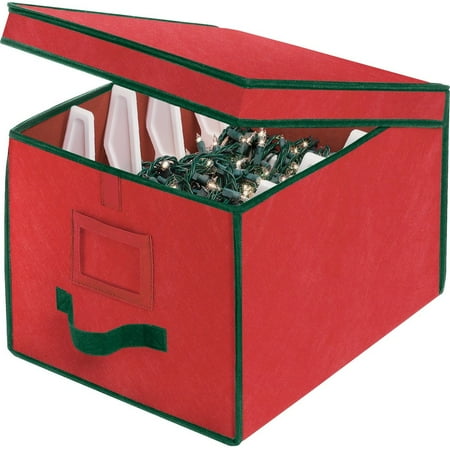
One of the most common Christmas decoration storage mistakes is throwing unwrapped string lights into a box. This almost always leads to knots that make decorating next year a nightmare. Invest in a light storage box that you can wrap your lights around dividers to prevent tangles. This box holds four sets of lights. Amélie adds, 'Wrap string lights around a piece of cardboard and write down where they go (such as this is the long one for the banister, that is the shorter one for the mantle, and here are the extension cords).'
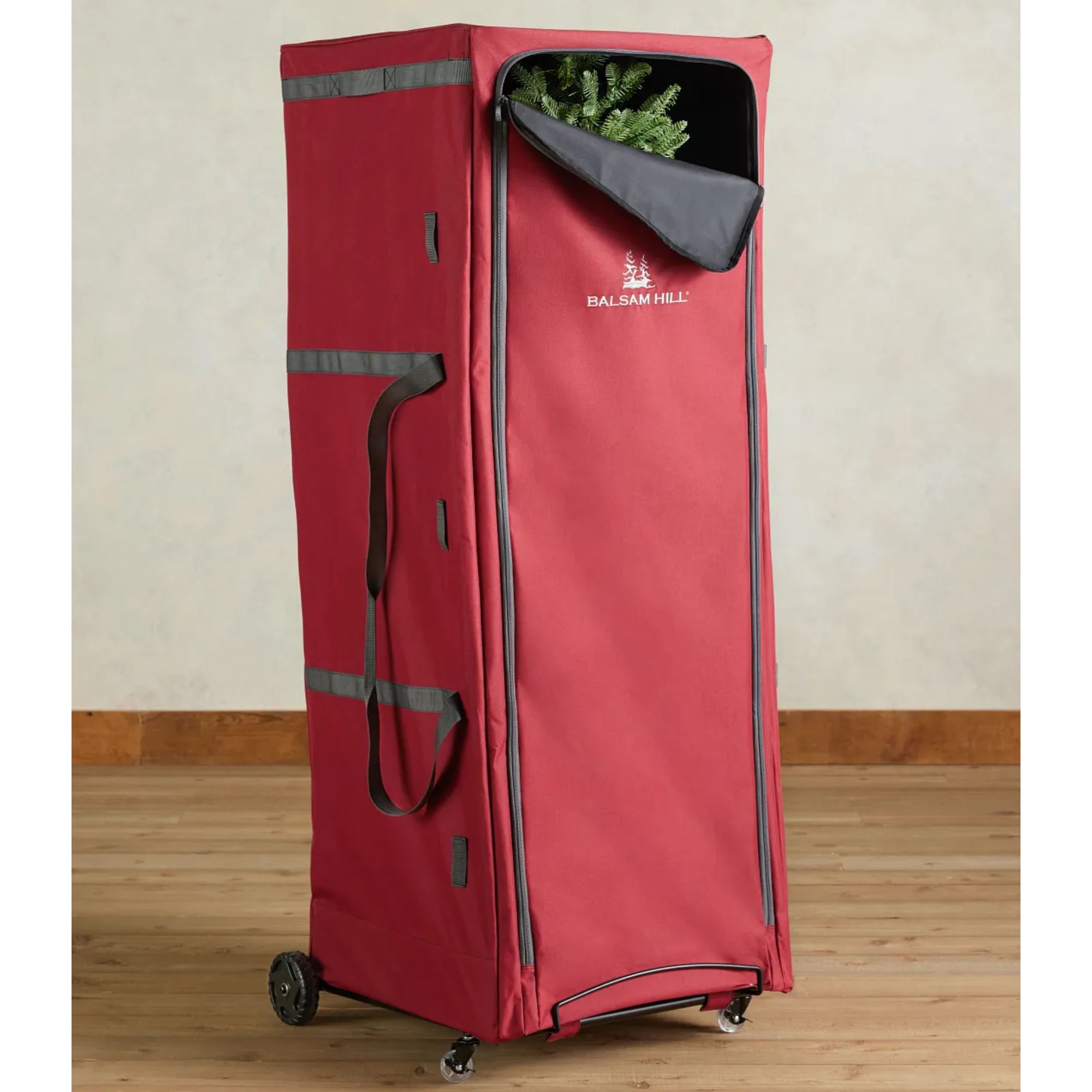
Storing a Christmas tree is one of the more difficult parts of un-decorating after the holidays. To keep yours safely stowed, Mac Harman, CEO of Balsam Hill, suggests using 'a storage bag that will protect your tree while it’s stored. Your bag needs to be large enough to comfortably hold your tree and made from durable material so that it can’t be torn by protruding branches – rip-stop nylon is a great option for this. Balsam Hill trees come with their own storage bags for ease. Store your tree in a cool, dry location to protect it from moisture and musty odor.'
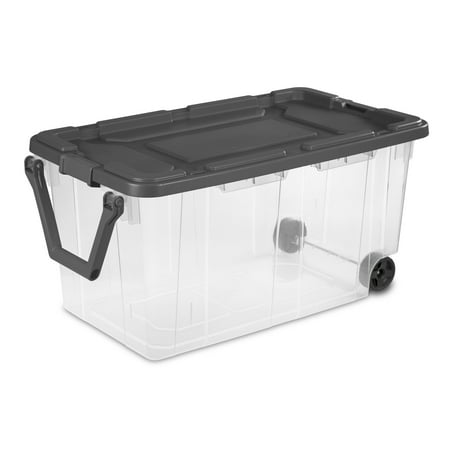
Home organizer Amélie suggests, 'Pack all items securely enough that you could move with the box as is, and pack by room rather than strictly by type of item. So if you have decorations that go on the mantle and others that go on the dining room server, pack them by location rather than putting all the candles together, all the figurines together.' A strong, wheeled box makes it simple to transport decor around your home.
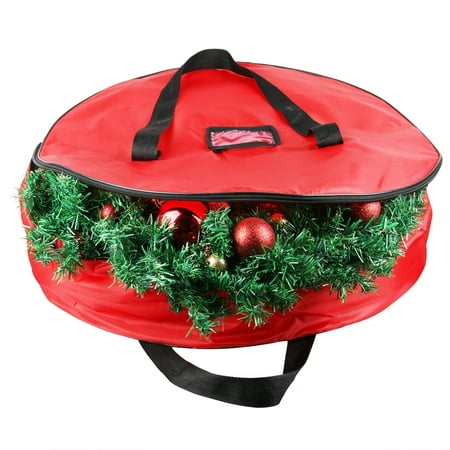
Keeping your Christmas wreath ideas looking their best long-term is a struggle. Investing in wreath storage bags that fit your door wreaths inside will help to protect them from dust and from being squashed in storage. Picking the perfect size will also ensure they keep their round shape between uses. If you have space in your attic, pop a long nail onto a wooden rafter and hang this bag from it to stop it getting squashed.
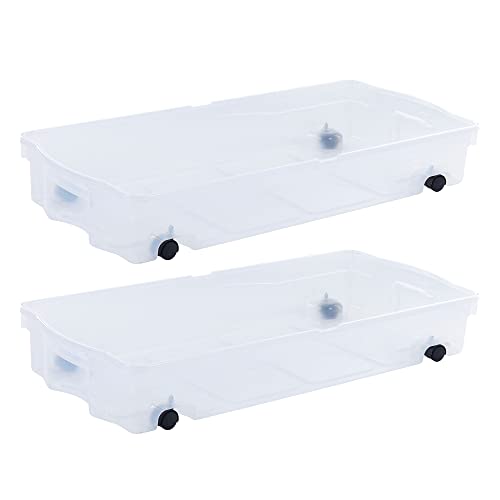
These long, wheeled, BPA-free storage bins are perfect for storing larger Christmas decorations such as garlands. Their slim profile and wheels make them excellent under-bed storage ideas, or they can be stacked in small spaces, such as attics, to save space. The wheels and transparency make them easy to roll in and out to find the items you're looking for.
Storing Christmas Trees
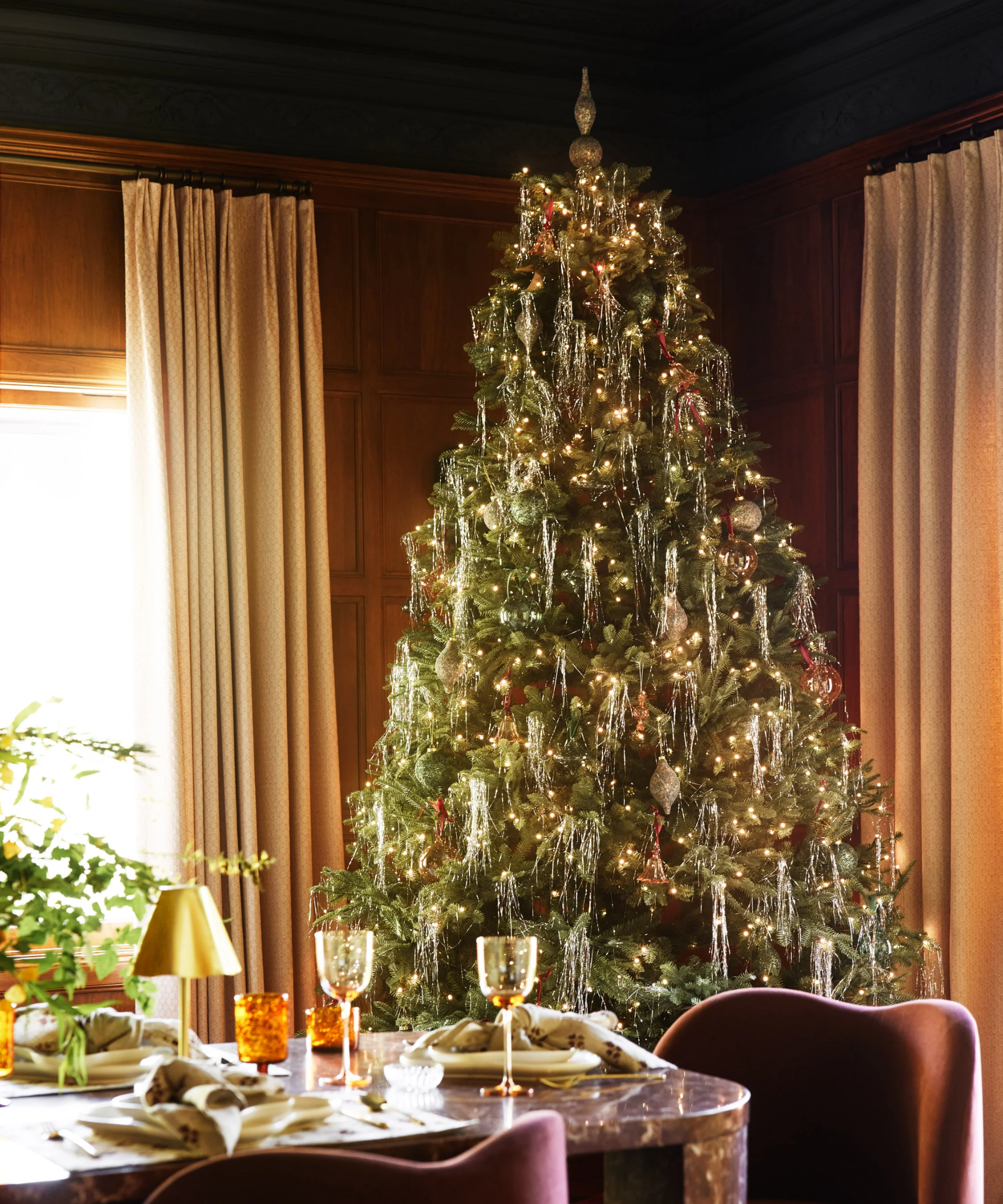
Put an artificial tree away with care to avoid damaging the branches.
For those who have an artificial Christmas tree, it's essential to preserve its quality while ensuring it is easy to store and move – all of which comes down to what your artificial tree is stored in.
1. Use the right container
If you have ever tried to wrestle a faux Christmas tree back into the box it came in, then you will know how it is almost impossible. To save yourself some time and energy, Amélie strongly recommends investing in a specialized Christmas tree bag, such as this from Amazon.
‘They are sturdy, have large handles and wheels, so it is easier to maneuver your tree in and out of storage each year,’ she explains. 'The hooks also allow you to hang it on the wall if you don't want it on the floor. I love a bag because not only does it keep the whole thing contained (so you don't have to go looking for half your tree if you're missing pieces), but it also keeps out dust and the elements.’
If you opt for a storage box, ensure the box is clean, dry, and adequately sized to fit the tree's components without excessive bending. Opt for a durable plastic storage box with a sealable lid to protect the tree from any damage and to keep out moisture, bugs, and dust.
Faux trees, garlands, and wreaths are prone to mold and mildew when stored in areas of the home that are not climate-controlled and can become a hazard, smell musty, or both.
2. Always take your tree apart before storing
To make your home organizing simpler, it helps to take your Christmas tree apart before storing it away, Amélie continues.
‘Before storing an artificial tree, make sure to take it apart (it is often in three sections) and fold down the branches before storing it in the bag, pole ends toward the middle. This helps keep the bag in good condition and will ensure that the branches aren't bent next year.’
Never put a tree away with the ornaments still on, as you risk damaging both your tree and your decorations. Cleaning an artificial Christmas tree is also a good idea to prolong its lifespan.
3. Keep trees out of basements and attics
Although attics and basements are some of the most common places to store a Christmas tree in the off-season, these are some of the spaces you should never use for home storage if you want your tree to last you for years to come, professional organizers warn.
Lauren Saltman, home organizer and founder of Living. Simplified. explains, ‘Although it's tempting to store a Christmas tree in the attic, basement, or garage, unfortunately, these are not optimal areas due to pests, temperature changes, and moisture, all of which can damage your faux Christmas tree.
‘If possible, find space in a closet within your home, preferably on a top shelf,’ Lauren suggests, making under-the-stairs organization a great place to start when looking for a new home for your tree.
That being said, if you really have nowhere else to store your tree, some accommodations can be made to protect your tree in unfavorable storage spots, assures Amélie.
‘As long as it's in a sturdy bag like the one I mentioned, it is protected just fine. Just note that this is not always the case with trees that have white limbs or fake snow, but for a green tree, I haven't seen any issues. The most important thing is to store the bag in a way that it won't come into contact with water or direct sunlight; having a bag also helps protect the tree against dust or insects that might want to nest in it.’
Storing Christmas Decorations
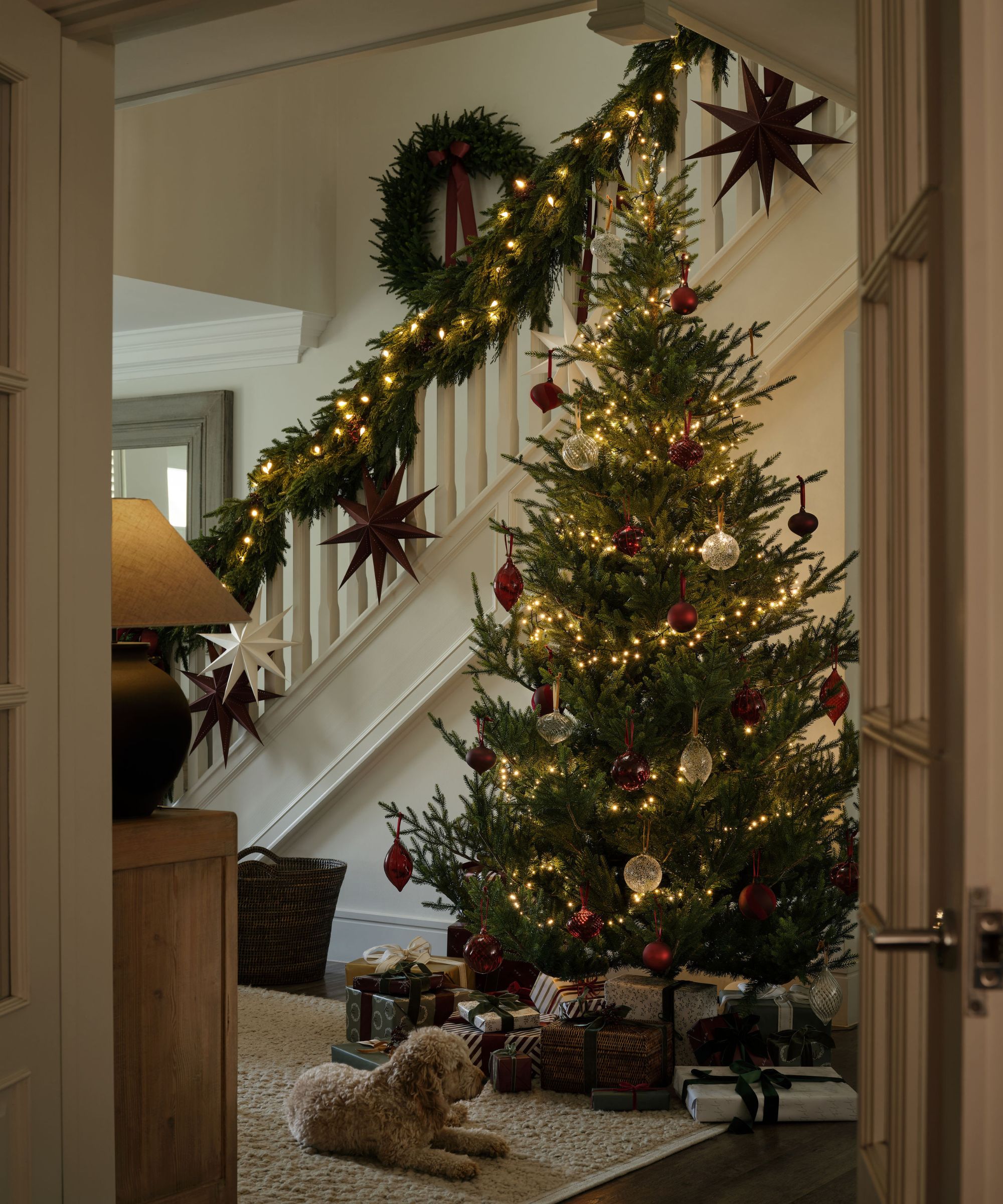
How and where you store your decor can make a big difference to how long they last.
1. Group by Use
Ashley La Fond, founder of home organization company Of Space & Mind, says, 'Store decor based on how you use them, rather than by type. So if you decorate your front porch with specific lights and decor, then keep those together. The same goes for trees – rather than storing all ornaments together, separate them by how and where they are used to make decorating faster and easier.'
If you keep different decorations for Christmas or Hanukkah, make sure it's clear. ‘Separate and store decorations by holiday so you can pull out only what you need rather than digging through bins,’ recommends La Fond.
2. Label Everything
Grouping will hold less value without an efficient labeling system in place. Interior designer, Kishani Perera says, 'One thing super organized people always do is label, label, label!
'Every box and container having a detailed and itemized list of all its contents saves hours in the future when trying to dig up your holiday gear. If your items are stored in various places, as may be necessary in a small space, one master list detailing the whereabouts of your various items would be of enormous aid.'
Use all manner of labeling and listing to give yourself clarity when it comes to decorating again next year. For added gusto, La Fond recommends storage that you can see into, without disruption. ‘Use clear bins with labels so you can see what you have and find what you want,' she recommends. Simple adhesive labels, at Amazon, will do the job just fine.
3. Keep Lights Wrapped Up
Christmas lighting ideas are by far some of the most irritating pieces to store and decorate with. They always get tangled in the box, despite being perfectly fine when we put them away.
Creator of PURE Design, Ami McKay suggests, ‘Try not to tangle your lights! Wrap them around a piece of cardboard stacked in bins or you can use storage reels in cases, available at The Container Store.’
Kienzle recommends separating these into individual bags, too. 'Each string of lights should be stored separately in a gallon-size Ziploc bag (which are great for many uses around the home). Wrap each string around a piece of cardboard to keep it from tangling before putting it in a bag.'
4. Consider Humidity
One of the most important things people who are good at storing Christmas decorations always do is pay attention to humidity levels and improve ventilation in their homes to keep decor safe from damage.
Kim Corey, professional home organizer and founder of Finely Sorted Organizing, says, 'Many out-of-the-way places one would store holiday items may not be up to snuff as far as moisture level goes. Using moisture-absorbing pouches, available at Amazon, with airtight bins can help preserve your favorite homemade and store-bought holiday decor.'
Kim also reminds us that we should be using plastic bins and never cardboard for long-term storage, especially in attics and basements. She wants, 'There may be pests lurking that are looking for new bedding material. Unsecured cardboard boxes look like a jackpot to them. Using a sturdy plastic airtight bin will avoid this damage. You want it to be good and sturdy, as cheaper bins can buckle under the weight of stacking and cause damage to the contents you want to preserve.
'Finally, ensure the area you store your decorations is easy to access and, most importantly, is clean. A clean, simple spot will make decorating easier and safer year on year, especially in multi-generational households.'
5. Use Uniform Bins
Whether you use clear or opaque bins, Caroline Roberts, professional organzier and owner of This Simplified Island, shares, 'I recommend that you use one kind of bin for everything so you can mix, match, and move things around more easily.
'Clear bins are perfect for looking and seeing what’s inside. You can find ones with wheels that are easy to move around, like these clear bins at The Container Store. The downside is that being able to see all of the items inside can make the space look cluttered. If your storage is in an attic or other rarely seen area, then it doesn’t matter if the area seems a little messy due to bins.
'If you store your Christmas décor in the garage or bedroom closet, the cohesive look of opaque bins will look nicer. You’ll just have to be extra careful to label thoroughly since you won’t be able to see inside without opening the lid.'
6. Declutter as You Go
One of the best storage tips any professional organizer will give you is to declutter your belongings as you pack them away. This saves time in the future and space in your storage areas, as well as trimming down your collection and reducing decorating overwhelm next year.
Jamie Hord, founder of Horderly Professional Organizing, 'Keep decluttering in mind when setting up and when taking down decorations. If you're purchasing new items, consider following the one-in-one-out rule and let go of something old in exchange for bringing in something new. This way, your decorations stay at a constant level and never overflow the space you have to store them in.'
7. Pack out Wreaths to Keep Their Shape
If you have faux Christmas garlands and Christmas wreaths then packing them away properly can help extend their life span and keep them as Christmas centerpieces for years to come. Luckily, there are two ways to do this.
Jamie Hord says, 'Wreath storage is a must. Everyone has experienced a squished wreath, and it's no fun trying to get it back to life. You most likely end up getting a new one, wasting your time and money. Use these round bins [from The Container Store] to keep your wreaths in tip-top shape.'
Alternatively, you can pack like objects together into storage to help keep them in shape, for example, store them with other bulky items like faux garlands.
For long or very bulky garlands, consider storing them straight in a tree storage bag with a long plank of wood to keep the bag flat and level, stopping the garland from bending and breaking in storage.
8. Pack Items Heaviest to Lightest
When finding homes for your decorations, be it organizing under the stairs, in the attic, or in the basement, it is best to avoid stacking things on top of one another unless they are in sturdy, hard-shell boxes, such as the highly rated Sterilite storage boxes, available at Amazon.
Using strong shelves to separate items, with the heaviest items at the bottom and lighter items at the top, will not only make your shelves more stable but will also make putting items back and getting them out safer for you.
If you do not have shelves and need to stack items, always stack the larger, heavier items at the bottom, avoiding putting items on top of storage bags with trees and garlands in them lest you squash them. If possible, store these upright against a wall so they are not flattened by their own weight, either.
9. Deal With the Tree Last
Once your ornaments are safely tucked away, you can get rid of your real Christmas tree and finally start to reclaim your home's footprint.
Cut The Clutter's Marie Bateson recommends, 'If you have a real Christmas tree, make a note of your local collection dates for trees. You may need to book this in advance and make a small payment, but it is worth it to avoid the needle-filled boot of the car and the queue at the recycling center. Book it for the day you will take the decorations down, if possible, but if it isn’t, put them outside where they can be collected, as they often don’t mind if they get wet.
'If it is an artificial tree and you have the box, dismantle it and when it’s safely packed, tape the box to make it secure, dust-free, and easier to carry – or you could get a tree bag to make it even easier,' she adds.
Jamie continues, 'Most people store Christmas trees in the basement, attic, or garage so it's important to cover them well to avoid any pests.
'Depending on what size tree you have, there are different products that can protect your tree for the years to come.' Tools such as the Zevo flying insect trap, from Walmart, can help to keep your decor safe, especially alongside natural cedar blocks, from Amazon.
10. Be Smart With Storage in Small Spaces
If you live in a small storageless home or an apartment, storage for seasonal items can be tricky.
Since holiday decorations typically only surface once a year, Cynthia Kienzle, Founder of The Clutter Whisperer of NYC, recommends storing them out of the space if available as an option. Some might be fortunate enough to have a storage cage in the basement of an apartment building. If not, you could consider keeping items off-site at a friend's or family member's home, or in another secure, temperature-controlled location.
You will also want to make sure that your chosen boxes, bags, and the like, work together, as well as with the space you are using.
Containers should fit snugly onto bookshelves or seamlessly in with closet storage. Cynthia continues, 'If at the top of a closet, the containers should fit on the shelves with little overhang. They can be deep or shallow, depending on the contents and height between shelves.'
It goes without saying that for a neat and curated finish, you will want to keep decorations behind closed doors where possible.
Meet the Experts

Laura Price is the owner of The Home Organisation. Laura Price's goal is to help others experience the benefits of living an organized life after discovering that organized homes brought her peace when raising three children in a hectic home. Hence the birth of The Home Organization, a dedicated team of professional organizers.

Amélie Saint-Jacques is a certified KonMari Consultant and professional organizer based in San Antonio with years of experience in professional tidying.

Lauren is a professional home organizer who specializes in working with busy families and retirees. She empowers her clients to take control of their environments for increased confidence at home.

Ashley is the founder of home organization company Of Space & Mind, which helps people implement storage solutions that combine aesthetics and efficiency. She loves finding clever closet storage solutions.

Starting in 2000, Finely Sorted Organizing, LLC has been helping people declutter, downsize, rightsize, rearrange the basement, clean out a family home, with closet makeovers, garage resets, kitchen retooling, office optimizations, mudroom triages, file cabinet overhauls help to ease anxiety and feelings of frozen immobility caused by lack of systemization in a world filled with curve balls.

Jamie is a certified professional home organizer and a member of the National Association of Professional Organizers, specializing in decluttering and organizing. Alongside Horderly’s success, Jamie has become one of the world’s most recognizable professional organizers, having been in the likes of Homes & Gardens, Architectural Digest, NY Times, Good Housekeeping, The Today Show, Forbes, and more.
With the last traces of Christmas back in safe storage, try out some fun decluttering methods to help you reset the rest of your home for the new year.

Chiana has been at Homes & Gardens for two years and is our resident 'queen' of non-toxic living. She spends most of her time producing content for the Solved section of the website, helping readers get the most out of their homes through clever decluttering, cleaning, and tidying tips. She was named one of Fixr's top home improvement journalists in 2024.